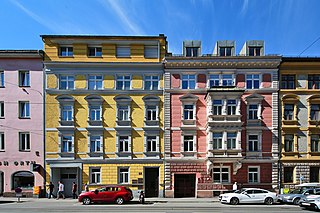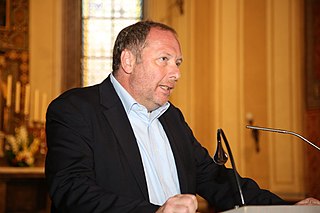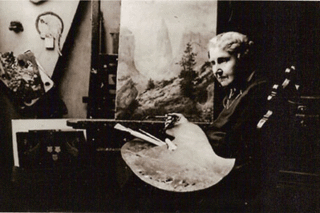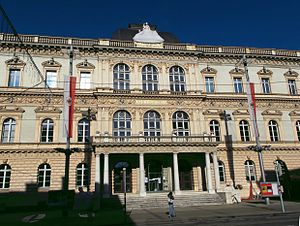
Innsbruck is the capital of Tyrol and the fifth-largest city in Austria. On the River Inn, at its junction with the Wipp Valley, which provides access to the Brenner Pass 30 km (19 mi) to the south, it had a population of 132,493 in 2018.

Bolzano is the capital city of the province of South Tyrol, in Northern Italy. With a population of 108,245, Bolzano is also by far the largest city in South Tyrol and the third largest in historical Tyrol. The greater metro area has about 250,000 inhabitants and is one of the urban centers within the Alps.

The Medical University of Innsbruck is a university in Innsbruck, Austria. It used to be one of the four historical faculties of the Leopold-Franzens-Universität Innsbruck and became an independent university in 2004.

Schwaz is a city in the Austrian state of Tyrol. It is the administrative center of the Schwaz district. Schwaz is located in the lower Inn valley.

Auer is a comune (municipality) and a village in South Tyrol in northern Italy, located about 15 kilometres (9 mi) south of the city of Bolzano.
The Kaiserjäger, were formed in 1895 as four normal infantry regiments within the Common Army of Austria-Hungary. Despite the name "Tirol" in its title its members were not just recruited from the crown land of Tyrol but also from other parts of the monarchy. The regiments were disbanded in 1918 with the end of the k.u.k. monarchy. The word Jäger is a characteristic term used for light infantry or light infantrymen in a German-speaking context.
Johann Chrysostomus Senn was a political lyric poet of the Vormärz.

The Tyrolean Rebellion is a name given to the resistance of militiamen, peasants, craftsmen and other civilians of the County of Tyrol led by Andreas Hofer supported by his wife Anna and a strategic council consisting of Josef Speckbacher, Peter Mayr, Capuchin Father Joachim Haspinger, Major Martin Teimer and Kajetan Sveth, against new legislation and a compulsory vaccination programme concerning smallpox ordered by King Maximilian I of Bavaria, followed by the military occupation of their homeland by troops organised and financed by Napoleon I of the First French Empire and Maximilian I. The broader military context is called the War of the Fifth Coalition.

Hessisches Landesmuseum Darmstadt (HLMD) is a large multidisciplinary museum in Darmstadt, Germany. The museum exhibits Rembrandt, Beuys, a primeval horse and a mastodon under the slogan "The whole world under one roof". As one of the oldest public museums in Germany, it has c. 80,000 visitors every year and a collection size of 1.35 million objects. Since 2019, Martin Faass has been director of the museum. It is one of the three Hessian State museums, in addition to the museums in Kassel and Wiesbaden. Similar institutions in Europe are the Universalmuseum Joanneum in Graz and the National Museum of Scotland in Edinburgh.

Karl, Count Chotek of Chotkow and Wognin ; was an Austrian chancellor, Government President (Gubernialpräsident) and school reformer of Bohemia and honorary citizen of Innsbruck and Prague.

Peter Assmann is an Austrian art historian, curator, writer and visual arts creator.

Norbert Pümpel is a visual artist who lives and works in Drosendorf an der Thaya in Austria.

Edgar Meyer (1853–1925) was an Austrian painter who built himself a castle and engaged in politics.

The Standschützen were originally rifle guilds and rifle companies that had been formed in the 15th and 16th centuries, and were involved time and again in military operations within the borders of the Austrian County of Tyrol. A Standschütze was a member of a Schützenstand, into which he was enrolled, which automatically committed him to the voluntary, military protection of the state of Tyrol. In effect they were a type of Tyrolean local militia or home guard.

The Tirol Panorama with the Museum of the Imperial Infantry or Tirol Panorama is a museum in Innsbruck in the Austrian state of Tyrol, which is mainly important because it houses the Innsbruck Giant Panorama Painting.

Johanna von Isser Großrubatscher, identified in one source as "the lady who drew castles", was an Austrian graphic artist and writer.

Gabriele Maria Deininger-Arnhard (31 July 1855 in Munich – 19 October 1945 Rum, Tyrol) was a German-Austrian painter.
The Andreas Hofer Kreuzer, also called the Hofer Kreuzer or Sandwirtszwanziger, was the name of the 20- and 1-kreuzer coins that were minted during the Tyrolean Rebellion in Hall in Tirol in 1809. The obverse depicts the Tyrolean Eagle and the inscription Gefürstete Grafschaft Tirol; the reverse shows the nominal value.

Albert Joseph Gasteiger, was an Austrian nobleman and engineering officer. Born in Innsbruck, he became an instructor at the Dar ol-Fonun in Qajar Iran, as well as the manager of all civilian and military buildings at the behest of Iran's government from 1860 to 1888. He died in Bozen.
Tarlan Rafiee is an Iranian artist, curator, and author known for her contributions to Iranian modern and contemporary art.

















